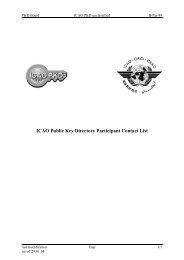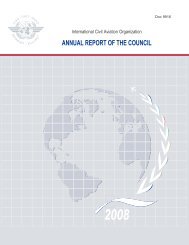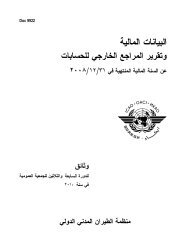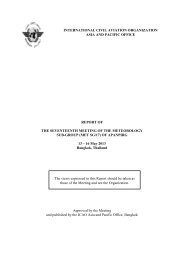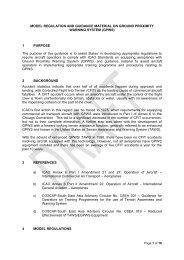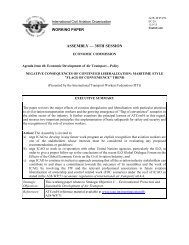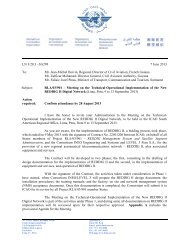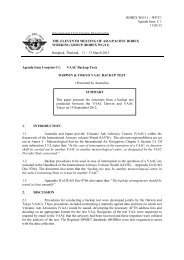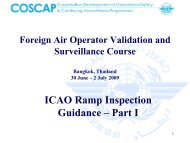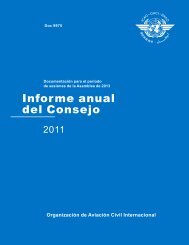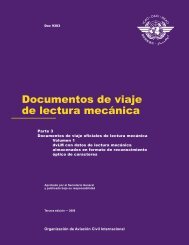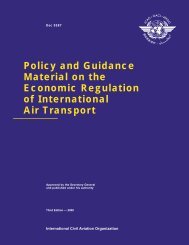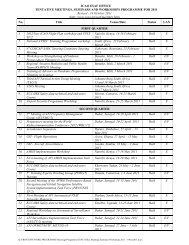afi met bulletins exchange (ambex) handbook - ICAO
afi met bulletins exchange (ambex) handbook - ICAO
afi met bulletins exchange (ambex) handbook - ICAO
Create successful ePaper yourself
Turn your PDF publications into a flip-book with our unique Google optimized e-Paper software.
AFI Regional SIGMET Guide Page6/60<br />
2. RESPONSIBILITIES AND COORDINATION<br />
2.1 General<br />
2.1.1 SIGMET is warning information, hence it is of highest priority among other types of<br />
<strong>met</strong>eorological information provided to the aviation users. The primary purpose of SIGMET is for inflight<br />
service, which requires timely transmission of the SIGMET messages to pilots by the ATS units<br />
and/or through VOLMET and D-VOLMET.<br />
2.1.2 Airlines are the main users of the SIGMET information. They contribute to the<br />
effectiveness of the SIGMET service through issuance of special air-reports reported by pilots to the ATS<br />
units. Special air-reports are among the most valuable sources of information for the Meteorological<br />
Watch Offices (MWO) in the preparation of SIGMET. The ATS units receiving special air-reports should<br />
forward them to the associated MWOs without delay.<br />
2.1.3 In view of the foregoing, it should be well understood that the effectiveness of the<br />
SIGMET service depends strongly on the level of collaboration between the MWOs, ATS units and<br />
pilots. That is why, close coordination between these parties, as well as mutual understanding of their<br />
needs and responsibilities, are essential for the successful implementation of the SIGMET service.<br />
2.1.4 For the special cases of SIGMET for volcanic ash and tropical cyclones, the MWOs are<br />
provided with advisories from the volcanic ash advisory centres (VAAC), and tropical cyclone advisory<br />
centres (TCAC) designated in the Regional ANP.<br />
2.1.5 Another use of SIGMET is for the flight planning. This requires global dissemination of<br />
SIGMET through the international OPMET data banks and the satellite broadcasts: ISCS and SADIS.<br />
SIGMET should also be distributed to the World Area Forecast Centres (WAFC) London and<br />
Washington for use in the preparation of the significant weather (SIGWX) forecasts.<br />
2.1.6 In the next paragraphs, the main responsibilities and coordination links,related to the<br />
provision of SIGMET information, are described.<br />
2.2 Meteorological Watch Office - responsibilities and procedures related to SIGMET<br />
2.2.1 SIGMET information should be issued by the <strong>met</strong>eorological watch offices (MWO) in<br />
order to provide timely warning for occurrence or expected occurrence of specified en-route weather<br />
phenomena, affecting the safety of the flight operations in the MWO’s area of responsibility (AOR).<br />
SIGMET provides information concerning the location, extent, intensity and expected evolution of the<br />
specified phenomena.<br />
2.2.2 Information about the provision of SIGMET service, including details on the designated<br />
MWO(s), should be included in the State’s Aeronautical Information Publication (AIP) as specified in<br />
Annex 15, Aeronautical Information Service, Appendix 1, GEN 3.5.8.<br />
2.2.3 All designated MWOs in the AFI Region are listed in Appendix A to this Guide extracted<br />
from the FASID AFI Table MET 1B. The MWOs situated outside of the AFI Region are in italic.<br />
2.2.4 If, for some reason, a State is not able to meet its obligations for establishing MWO(s)<br />
and for provision of SIGMET for the FIR(s) or control area(s) the State is providing air traffic services,<br />
arrangements should be made between the <strong>met</strong>eorological authorities of the States concerned, that another<br />
September 2007 Amend1/2010 Ninth Edition



